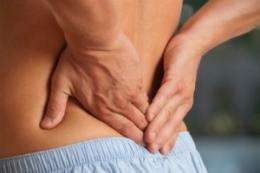“This research marks an important finding for clinicians. It serves as an objective monitoring tool for patients suffering from back pain under treatment and rehabilitation.”— Mr Ruhe.
Back pain has a direct linear link with a person’s balance, according to new research from a Murdoch University PhD student.
While chiropractor Alex Ruhe said there had always been a known relationship, this was the first time a linear connection had been established.
“Possibly [the] relationship was deemed of low relevance because few direct clinical applications arise from it,” he says.
Using 210 patients with low-back, mid-back and neck pain, Mr Ruhe asked them to rate their pain on a scale from zero (no pain) to 10 (the worst possible pain).
Body sway was measured on a solid fore plate after patients closed their eyes and changes in weight shifts were recorded by pressure sensors in each corner of the plate.
The recordings of pain sufferers were compared to sway data from healthy individuals of a similar age.
“We discovered body sway increased with higher pain intensities and this increase followed a linear fashion,” Mr Ruhe said. “Similar results were observed for the three painful regions.
“In follow-up studies, we observed changes in body sway as pain decreased after a course of three manual therapeutic interventions at three to four day intervals.
“The results showed that sway was lowered as pain levels decreased, maintaining the linear relationship previously observed.
“Long-term damage or changes to the nervous system due to the pain appears unlikely because reduced sway in association with pain reduction was observed after just a few days.”
As a result of his research, Mr Ruhe said the focus should be on pain control when treating people with back pain in the future, particularly the elderly.
“The age-related decrease in neurological function renders them prone to falls and sustaining injuries as a consequence,” he said.
“Previous theories regarding damage to and adaptations of the nervous system because of chronic painful stimulation appear less likely.
“Instead, pain interference appears more to be a cause of increased postural sway in patients.”
Mr Ruhe said, in simple terms, this referred to decreased muscular control due to a painful stimulus inhibiting normal automatic body sway corrections.
“A return-to-normal body sway occurred directly following a pain decrease—a longer recovery period would have been expected in the case of neurological damage,” he said.
“This research marks an important finding for clinicians. It serves as an objective monitoring tool for patients suffering from back pain under treatment and rehabilitation.”
Provided by ScienceNetwork Western Australia




















